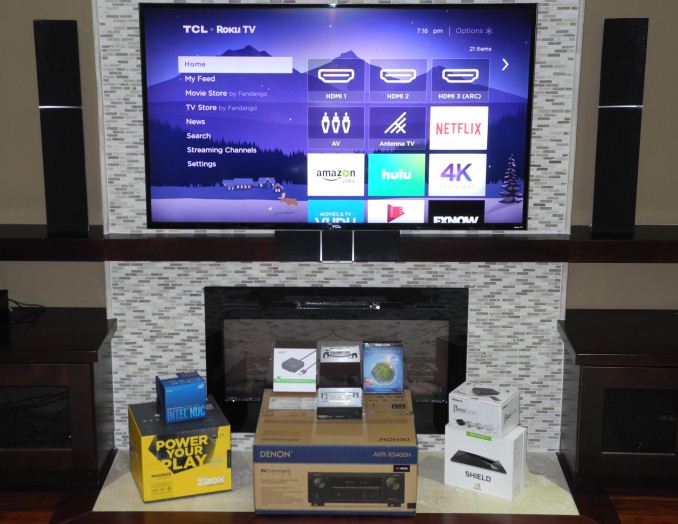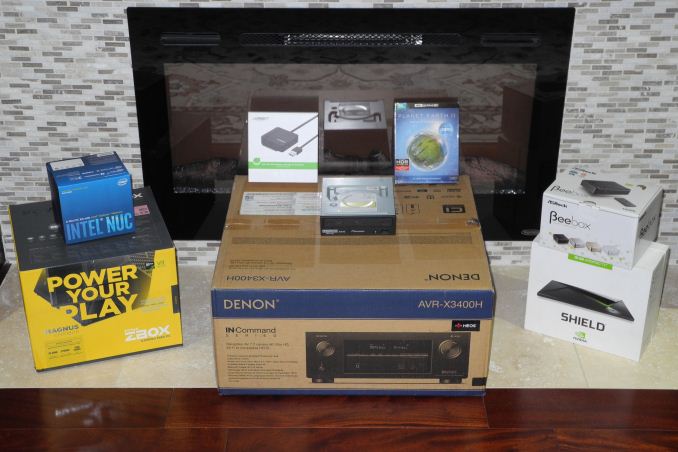A Budget Home Theater & PC Setup: 4K, HDR, UHD Blu-ray, and More
by Ganesh T S on December 26, 2017 8:30 AM EST
The days of bulky HTPCs with built-in optical drives, massive internal storage arrays, and integrated TV tuners are long gone. The advent of over the top (OTT) online streaming services has moved a lot of functionality to the cloud. As NAS units become more powerful, it has made sense to move local media files to a central repository. All these have enabled the TV-connected PC to become more compact. Unless the consumer has specific requirements (like, say, high quality gaming), even ultra-compact form factor (UCFF) machines such as the Intel NUCs can fit the bill.
Home Theater Components: Keeping up with the Times
The primary functionality of HTPCs has evolved to become one of a powerful and versatile media player. However, recent advances such as 4K and high dynamic range (HDR) videos, as well as stricter DRM requirements such as HDCP 2.2 for premium content have made the perfect HTPC platform difficult to achieve. Before delving deeper into these new advances, it is helpful to have some insight into how the landscape has changed over the last decade or so. The advancements in that timeframe have meant that next attractive home theater feature was always around the corner. In the initial days of 720p televisions and other home theater equipment, it was Full HD (1080p). As 1080p became widespread, it was HD audio bitstreaming. After that, 3D support was sought after. A brief lull ensued before the market started slowly getting ready for 4K.
Over the last year or so, we have seen the appearance of displays and audio/video receivers (AVRs) supporting HDMI 2.0 / HDCP 2.2 along with HDR / Dolby Vision. Despite the announcement of HDMI 2.1, I believe that we have reached a point where it is possible to purchase a relatively inexpensive home theater and HTPC configuration without worrying about it getting obsolete within the the next 3 to 5 years.
On the media side, OTT streaming services have become popular to the extent that Netflix and YouTube moved to offer 4K videos to consumers ahead of Blu-rays. Fortunately, many modern PCs are capable of 4K Netflix playback, though HDR is available only on a subset of those configurations. UHD Blu-ray playback support is available through CyberLink PowerDVD 17. However, the hardware requirements are a lot more specific compared to premium OTT services. UHD Blu-ray playback with HDR requires that the home theater components fulfill additional requirements.
Building a Home Theater on a Budget
I started work on this home theater piece back in June 2017. The aim was to present a setup (TV, AVR, and HTPC) with all the bells and whistles, yet light on the wallet. While the TV (TCL 55P607) and the AVR (Denon AVR X3400H) were easy to narrow down based on the feature requirements and budget, the PC side proved to be more challenging. Our core requirements (compact form factor, 4K Netflix support, and HDR capability) narrowed down the choices to a NVIDIA Pascal GPU-equipped PC or a Kaby Lake PC with HDCP 2.2 capabilities. UHD Blu-ray support further narrowed this down to certain Kaby Lake PCs with a HDMI 2.0 / HDCP 2.2 display output.
In the course of our evaluation, we found that consumer electronic (CE) equipment almost always received features ahead of HTPC platforms. Keeping this in mind, we ended up evaluating a number of options for the fulfillment of HTPC duties
- Roku Smart TV platform in the TCL 55P607
- NVIDIA SHIELD Android TV (SATV)
- Zotac ZBOX MAGNUS EN1080K
- ASRock Beebox-S 7200U
- Intel NUC7i7BNHX
Prior to looking at the performance of these options, it will be of interest to readers to delve deeper into our choice for the other home theater components. Earlier this year, I happened to embark on a house remodel, and I took that opportunity to revamp the HTPC test components used in our system reviews. Our choice of components is geared towards a typical family room (15' x 15') home theater.











191 Comments
View All Comments
Azethoth - Monday, January 1, 2018 - link
Why don't you go read an article on _not_ home theater, and regale everyone with how awesome the sound from your shitty TV speakers are. Home theater is simply not for your budget, but don't pretend everyone is living in mom's basement.This article may be out of touch with the 5 of you, but it is not out of touch with the rest of the readers.
Why not go whine in articles about supercars about how they are out of touch with 99.999999% of the planet. Oh noes! I still want to read about them though.
Sivar - Wednesday, January 3, 2018 - link
Most Anandtech readers are tech-savvy, but not tech experts and have normal homes, eyes, ears, and middle-level income (of those in the United States).Talk of an OLED TV or projector tells me that it is you who is out of touch with readers, and it doesn't help that your statement to the author was inappropriately rude.
OLED TVs have an objectively better picture quality, but are much more expensive and the difference is not that noticeable to most people.
Projectors are great (I use one) but are impractical for many (most?) homes because they need light control and, for good pricing, a large flat wall for the screen.
Regarding speakers, if the implication is that there is no noticeable difference between them, then yI suspect you are not at all an enthusiast of home theater. This isn't even a reasonable debate, it just leaves me dumbfounded. True that there is little difference between an extremely fancy speakers (say from Focal or Magico) and a good set of well-designed towers such as those from Ascend or JBL, and indeed the audio industry has a lot of snake oil like expensive cables and any Bose product, but to say that a speaker "works or it doesn't" proves little experience with sound systems, even in the sub-$500 range.
SunnyHours - Wednesday, July 11, 2018 - link
Totally agree with you there!Especially your comment about Cables, Bose (I HATE BOSE!) and mostly the comment that "either a speaker works or it doesn't" that just really surprised me and made me wonder how this person can even entertain the idea of giving tips on a subject you know nothing about...especially on the internet where people will put you on the spot and call you for being an ignorant person and at the same time being a "know it all".
Next thing he will say is that "Vinyls sound like crap and cassettes were a much improved product" LOL.
Dug - Friday, January 5, 2018 - link
He's not out of touch. A good balanced receiver will last much longer in a system than video. Most people upgrade video (tv's, monitors, etc), than they do sound. Projectors don't really fall into the family room scenario either. Usually too much light, sound, maintenance, setup, etc. Plus there's no real 4k hdr affordable projectors out.Bullwinkle-J-Moose - Thursday, December 28, 2017 - link
"So you want a home theater system but don't want to get an AV receiver?"-----------------------------------------------------------------------------------------------------
Why not?
I have a 35 Watt dual-core Sandy Bridge with optical audio output to my Digital EQ (Behringer DEQ24/96) and Balanced XLR to each JBL LSR305 powered monitor
(Behinger AD converters sound like crap but with an optical input, it sounds Fantastical)
Much better than a Denon receiver I do believe
Sure, it's completely Gimped when its running Windows 10 DRM garbage
But, if I want to run 4K on a Gimped System, I can boot to 7 / 8.1 or Spyware Platform 10
I'm running Windows XP right now so I don't need to worry about Bluescreens of Death, malware, or Viruses like I do with Spyware 10
Burns BlueRay Disks fine and can boot to a stock install of XP in 3-4 seconds from a Samsung 850 Pro
Any computer newer than Sandy Bridge is nothing more than a Locked Down Gaming Console with a web browser attached and they make for really piss poor home theater setups
"Personal" Computers died with Sandy Bridge!
You are just renting a JukeBox
Azethoth - Monday, January 1, 2018 - link
I am missing the part where your "fantastical" Behringer DEQ24/96 decodes Dolby Surround.You are failing at Home Theater. There are standards. One of them is surround sound.
Stereo is for listening to old timey music. I am willing to put my Denon in surround stereo up against your stereo thing anytime. I will also pretend that Denon is better, except it would actually be true unlike your imaginings where an optical in somehow makes a difference.
Just so you know, hard science and engineering tells us that an optical in connection means you 100% do not have what this article is about: the more part of 4k blu ray. Atmos does not fit into optical. Hell, 7.1 and 9.1 surround did not fit.
So you and the rest here are just bloviating without saying anything relevant to the topic.
tl;dr If it is beyond your budget, quit whining and read the follow up article next year. Everything will be cheaper and better.
Bullwinkle-J-Moose - Monday, January 1, 2018 - link
"I am missing the part where your "fantastical" Behringer DEQ24/96 decodes Dolby Surround.You are failing at Home Theater. There are standards. One of them is surround sound."
--------------------------------------------------------------------------------------------------------------------
There is no "Standard" to Home Theater!
Surround Sound is one of many so called "Standards"
Your "Budget" demands "Your Standards"
3.1 / 5.1 / 7.1 / 9.1 are simply additions to the 3.0 "Standard" that I created over 30 years ago
They do not Image a "Standard" stereo output as well as mine and yet you claim "They" are the "Standard"
Advertising propaganda has taught you well
Now go forth and spew nonsense
A "Budget" Home Theater can be whatever you want it to be
Racing Stripes and RGB lighting may cost extra
Reflex - Monday, January 1, 2018 - link
I am unclear on how your setup will do positional audio in a home theater setup. For instance, if I play back DD5.1 content, will your setup put the appropriate audio and effects behind a viewer? If I play Dolby Atmos or DTS X content, will it additionally place the appropriate audio above the viewer's head? If so, how are you handling the decode operation for those standards to translate them to your proprietary speaker number and arrangement?Thanks!
Bullwinkle-J-Moose - Tuesday, January 2, 2018 - link
"If I play Dolby Atmos or DTS X content, will it additionally place the appropriate audio above the viewer's head? If so, how are you handling the decode operation for those standards to translate them to your proprietary speaker number and arrangement?"-------------------------------------------------------------------------------
I support my original "Reference Standard" which preceded Atmos and DTS X
I do not support other "Non-Standards" which came later
The only way a "Non-Standard" Home Theater experience can match the "Stereo" Imaging accuracy of my Reference "Standard" is to steal my design
If Dolby or anyone else can claim to match the Imaging accuracy of my Reference Design, then there are really only two possibilities here that I can see
A: They stole my design
or
B: They are Liars
There either ONE Reference, or there is no reference
Choose Now!
Bullwinkle-J-Moose - Tuesday, January 2, 2018 - link
There is either ONE Reference, or there is no reference at all